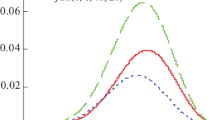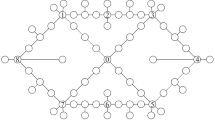Abstract
An improved method of equivalent random traffic (ERT) has been developed, thus making it possible to compute the parameters of splitting flows of calls, which makes it different from the classical ERT method operating only with combined flows of calls. The numerical analysis indicated that this method has an increased accuracy for independent flows. For dependent flows, the approximation’s accuracy is reduced, and the correlation between them should be taken into account.
Similar content being viewed by others
References
Iversen, V.B., Teletraffic Engineering and Network Planning, 2006, http://www.com.dtu.dk/education/34340/
Riordan, J., Derivation of Moments of Overflow Traffics, Bell System Tech. J. 1956, vol. 35, 507511.
Rapp, Y.K., Planning of Junction Network in a Multi-Exchange Area, Ericsson Technics, 1964, vol. 20, no. 1, pp. 77–130.
Szybicki, E., Numerical Methods in the Use of Computers for Telephone Traffic Theory Applications, Ericsson Technics, 1967, vol. 23, no. 4, pp. 439–475.
Hedberg, I., A Simple Extension of the Erlang Loss Formula with Continuous First Order Partial Derivatives, L.M. Ericsson, Internal Report XF/Sy 81 171.
Schneps-Schneppe, M. and Sedols, J., On Erlang B-Formula and ERT Method Extension, Proc. International Congress on Ultra Modern Telecomm. Control Syst. Workshops (ICUMT), (ICUMT-2010), Moscow, 2010.
Wilkinson, R.I., Theories for Toll Traffic Engineering in the USA, The Bell System Tech. J., 1956, vol. 35, pp. 421–514.
Bretschneider, G., Die Berechnung von Leitungsgruppen fur uberfliessenden Verkehr in Fernsprechwahlangen, Nachr. Techn. Zeitschrifift, 1956, vol. 9, pp.533–540.
Fredericks, A.A., Congestion in Blocking Systems—a Simple Approximation Technique, The Bell System Tech. J., 1980, vol. 59, no. 6, pp. 805–827.
Author information
Authors and Affiliations
Corresponding author
Additional information
Original Russian Text © M.A. Schneps-Schneppe, J.J. Sedols, 2011, published in Avtomatika i Vychislitel’naya Tekhnika, 2011, No. 2, pp. 36–45.
About this article
Cite this article
Schneps-Schneppe, M.A., Sedols, J.J. Application of Erlang’s formula for non-Poisson flows. Aut. Conrol Comp. Sci. 45, 86–93 (2011). https://doi.org/10.3103/S0146411611020064
Received:
Published:
Issue Date:
DOI: https://doi.org/10.3103/S0146411611020064




